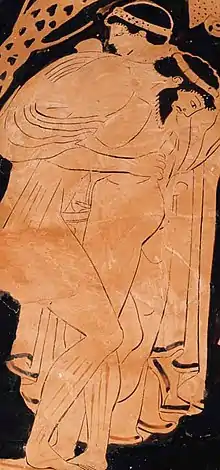Intercrural sex
Intercrural sex, also known as coitus interfemoris,[2] thigh sex[3] and interfemoral sex,[4] is a type of non-penetrative sex, where the penis is placed between the receiving partner's thighs and thrusted to create friction. It was a common practice in ancient Greek society until the early centuries AD. As history went on it became subject to sodomy laws and become seen as a sin that one needed to repent for. The 17th century saw it take cultural prominence—being seen as a part of male-on-male sexual habits—and was discussed within multiple pieces of literature.

In modern times, intercrural sex is commonly practised; adult women are said to use it to stimulate orgasm.[5] In southern Africa and parts of Asia—like Sri Lanka—the practice is normalised and is expressed among both heterosexuals and between homosexual males. Knowledge regarding intercrural sex and its relation to acquired immunodeficiency syndrome (AIDS) and pregnancy is low. Studies have found it composing a small percentage of sexual assault cases.
Etymology
The term intercrural sex was first introduced by Kenneth Dover in his 1978 book Greek Homosexuality. Dover used the term to refer to sex between an older man and a young boy.[1] The Ancient Greek term for this practice was διαμηρίζειν diamērizein ("to do [something] between the thighs").[6] Webster's Dictionary defines it as where one partner “plac[es his] penis...between the other partner's [closed] thighs...[and thrusts] to create friction".[7]
Kang Tchou notes that Dover's definition is similar to the idea of "heavenly love", articulated by Pausanias, which "encourages a stable life-long relationship between the boy and the man and enhances the intellectual development of the younger boy".[1]
History and modern practice
Ancient history and the Middle Ages
Intercrural intercourse was a common manifestation of pederasty in ancient Greece.[1] Dover has suggested that it was the preferred activity and was done to pervent "breaching whatever protocols happened to be in force concerning same-sex actions".[7][8] Alexander the Great reportedly had intercrural sex with Hephaestion.[9] By the early AD eta, however, it fell out of fashion as relations between men and women become more favoured.[1] It was depicted on artworks such as vases, where they were called "courting scenes", and heavily discussed by writers.[1][10][lower-alpha 1] Joan Roughgarden refers to standing, face-to-face intercrural intercourse as the "gay male missionary position" of Ancient Greece.[12]
It had been subject to various historical sodomy laws and religious restrictions enacted mostly by Christianity.[13] Medieval penitentials often highlighted intercrural sex as sinful and gave instructions on how to repent.[7]
Modern history

In early modern english, writers referred to intercrural sex by "rubbing” or “frigging”.[7] Literary works like The School of Venus, The Choise of Valentines and The Lady of Pleasure depicted intercrural sex, with the first two speculated, by Will Fisher, to have encouraged people to perform the act.[7] Works of satire at the time also discussed the act, specifically male-on-male intercrural sex.[7] Cases of sodomy at this time, such as the trial of the Mervyn Tuchet in 1631, occasionally mentioned intercrural sex.[7] Tuchert's case took on significant cultural prominence at the time and informed many of male-on-male sexual habits and likely created a perception of intercrural sex being the main method.[7]
In Africa, intercrural sex was one of many forms of sexual socialisation amongst young people that was critiqued by Christianity.[14] In Japan it is known as sumata.[15] In Zulu it is referred to as okusoma. It has a long history as an accepted practice for young people in southern Africa and was often practiced to prevent population growth.[16][17]
Statistics
Sexual assault
Hickson et al. (1994) found that in 5 of 219 cases of male sexual assault reviewed, intercrural sex took place.[18] In Sri Lanka, 2014, 270 instances of sexual assault were medically examined; 18 occurrences of intercrural intercourse were reported.[19] No physical injuries occurred to the victims.[19] They were reported between the age of 4 and 19 years with the average being 14 years old.[19]
Education
Ripley et al. 1971, demostrated that only 3 out of every 10 boys and 4 of every 10 girls in the 14-year-old age group, surveyed, were under the impression that intercrural intercourse could not result in pregnancy.[20][lower-alpha 2] In southern Africa it has been seen as a method of preventing acquired immunodeficiency syndrome (AIDS), with 12.5% of girls responding with it when asked how to not acquire AIDS.[21] In Nigeria, only 13 of 298, human immunodeficiency virus (HIV) positive respondents knew that the disease could be transmitted through intercrural sex, while a further 30 said "no" and the remaining 255 responded with "[didn't know]".[22]
Demographics
Shere Hite's 1976 and 1981 research on female sexuality found that some adult women reported being able to achieve orgasm via intercrural contact to stimulate the clitoris.[5] Intercrural sex is popular in Sri Lanka with 4.2% of women, surveyed, reported to have engaged in it while 20.7% of men said to have had homosexual intercrural sex.[23] A 1997 report on the sexual health needs of males who have sex with males in the Calcutta suburbs found that 73% of men, asked, engaged in intercrural sex, though the frequency varied based on demographic factors: only 54% of sex workers, 50% of lower income men and 40% of Muslims reported intercrural sex, while 82% of Hindus and 88% of middle income men reported engaging in it.[24]
See also
References
- Tchou, Kang (2008). "Purificatory Hermeneutics of Desire". Comparative Humanities Review. 2 (1). Archived from the original on 19 December 2020. Retrieved 18 December 2020.
- Mistry, Hannah; Jha, Swati (2 November 2015). "Pregnancy with a pinhole introitus: A report of two cases and a review of the literature". The European Journal of Contraception & Reproductive Health Care. 20 (6): 490–494. doi:10.3109/13625187.2015.1044083. ISSN 1362-5187. PMID 25960283. S2CID 207523628.
- De Vries, Hein; Eggers, Sander Matthijs; Jinabhai, Champak; Meyer-Weitz, Anna; Sathiparsad, Reshma; Taylor, Myra (1 August 2014). "Adolescents' Beliefs About Forced Sex in KwaZulu-Natal, South Africa". Archives of Sexual Behavior. 43 (6): 1087–1095. doi:10.1007/s10508-014-0280-8. ISSN 1573-2800. PMC 4133072. PMID 24729133. Archived from the original on 19 December 2020. Retrieved 19 December 2020.
- Blondell, Ruby; Ormand, Kirk (2015). "Ancient Sex: New Essays" (PDF). The Ohio State University Press. p. 32. Archived (PDF) from the original on 20 December 2020. Retrieved 19 December 2020.
- Hite, Shere (2004). The Hite Report: A Nationwide Study of Female Sexuality. New York, NY: Seven Stories Press. pp. 277–284. ISBN 978-1-58322-569-1. Archived from the original on 15 June 2013. Retrieved 8 May 2016.
- Dover, K. J. (1978). "The Prosecution of Timarkhus". Greek Homosexuality. Cambridge, Massachusetts: Harvard University Press. p. 98. ISBN 0674362616. OCLC 3088711.
- Fisher, Will (1 January 2015). ""Wantoning with the Thighs": The Socialization of Thigh Sex in England, 1590–1730". Journal of the History of Sexuality. 24 (1): 1–24. doi:10.7560/JHS24101. ISSN 1043-4070. S2CID 141561814. Archived from the original on 19 December 2020. Retrieved 19 December 2020.
- Tatum, James (2010). "Auto-Obituary". Southwest Review. 95 (1/2): 304–325. ISSN 0038-4712. JSTOR 43473061. Archived from the original on 19 December 2020. Retrieved 19 December 2020.
- Lane Fox, Robin (1994). Alexander the Great. London: Penguin Books.
- Percy, William A. (1996). Pederasty and Pedagogy in Archaic Greece. University of Illinois Press. p. 116. ISBN 978-0-252-06740-2. Archived from the original on 20 December 2020. Retrieved 19 December 2020.
- Blondell, Ruby; Ormand, Kirk (2015). "Ancient Sex: New Essays" (PDF). The Ohio State University Press. p. 40. Archived (PDF) from the original on 20 December 2020. Retrieved 19 December 2020.
- Roughgarden, Joan (2004). Evolution's Rainbow. Berkeley: University of California Press.
- Karras, Ruth Mazo (1 June 1999). "Prostitution and the Question of Sexual Identity in Medieval Europe". Journal of Women's History. 11 (2): 159–177. doi:10.1353/jowh.1999.0005. ISSN 1527-2036. S2CID 143952834. Archived from the original on 20 September 2020. Retrieved 19 December 2020.
- Macleod, Catriona (1 May 2009). "Danger and Disease in Sex Education: The Saturation of 'Adolescence' with Colonialist Assumptions". Journal of Health Management. 11 (2): 375–389. doi:10.1177/097206340901100207. ISSN 0972-0634. S2CID 73166118. Archived from the original on 19 December 2020. Retrieved 19 December 2020.
- Constantine, Peter. Japan's Sex Trade: A Journey Through Japan's Erotic Subcultures. Tokyo: Yenbooks, 1993, p. 75. ISBN 978-4-900737-00-6.
- Kaarsholm, Preben (2005). "Moral Panic and Cultural Mobilization: Responses to Transition, Crime and HIV/AIDS in KwaZulu-Natal". Development and Change. 36: 133–156. doi:10.1111/j.0012-155X.2005.00405.x.
- Klugman, Barbara (1 February 1991). "Population policy in South Africa: A critical perspective". Development Southern Africa. 8 (1): 19–34. doi:10.1080/03768359108439567. ISSN 0376-835X. PMID 12284789.
- Hickson, Ford C. I.; Davies, Peter M.; Hunt, Andrew J.; Weatherburn, Peter; McManus, Thomas J.; Coxon, Anthony P. M. (1 June 1994). "Gay men as victims of nonconsensual sex". Archives of Sexual Behavior. 23 (3): 281–294. doi:10.1007/BF01541564. ISSN 1573-2800. PMID 8024441. S2CID 26991937. Archived from the original on 20 December 2020. Retrieved 19 December 2020.
- Senanayake, S. M. H. M. K.; Karunathilaka, H. A. (30 June 2017). "Age and injury patterns of female survivors of different alleged sexual assaults examined in the Teaching Hospital Anuradhapura, Sri Lanka". Sri Lanka Journal of Forensic Medicine, Science & Law. 8 (1): 23–32. doi:10.4038/sljfmsl.v8i1.7790. ISSN 2465-6089. Archived from the original on 19 December 2020. Retrieved 19 December 2020.
- Ripley, G D (1973). "Sex Education – Whose Baby?". Proceedings of the Royal Society of Medicine. 66 (3): 267–269. doi:10.1177/003591577306600332. ISSN 0035-9157. PMC 1644813. PMID 4697995. Archived from the original on 19 December 2020. Retrieved 19 December 2020.
- Varga, Christine A. (1997). "Sexual decision-making and negotiation in the midst of AIDS: youth in KwaZulu/Natal, South Africa". Health Transition Review. 7: 45–67. ISSN 1036-4005. JSTOR 40608688. Archived from the original on 19 December 2020. Retrieved 19 December 2020.
- Ikechebelu, J.; Mbamara, S.; Joe-Ikechebebelu, N.; Ezenwabachili, A. (2009). "Sexual practices of people living with HIV in south eastern Nigeria". Nigerian Journal of Clinical Practice. 12 (4): 416–20. doi:10.4314/njcp.v12i4.54642 (inactive 20 January 2021). ISSN 1119-3077. PMID 20329684.CS1 maint: DOI inactive as of January 2021 (link)
- Perera, B.; Reece, M. (1 July 2006). "Sexual behavior of young adults in Sri Lanka: Implications for HIV prevention". AIDS Care. 18 (5): 497–500. doi:10.1080/09540120500241538. ISSN 0954-0121. PMID 16777642. S2CID 22962445. Archived from the original on 20 December 2020. Retrieved 19 December 2020.
- "Needs Assessment of Males who have Sex with Males in Calcutta and its Suburbs" (PDF). Naz Foundation International. 1997. Archived from the original (PDF) on 8 September 2008. Retrieved 26 October 2009.
Notes
External links
| Wikimedia Commons has media related to Intercrural sex. |
- Pre-marital intercrural sex known as soma in Zulu tradition
- Dan Savage on Abraham Lincoln and femoral intercourse (third letter)